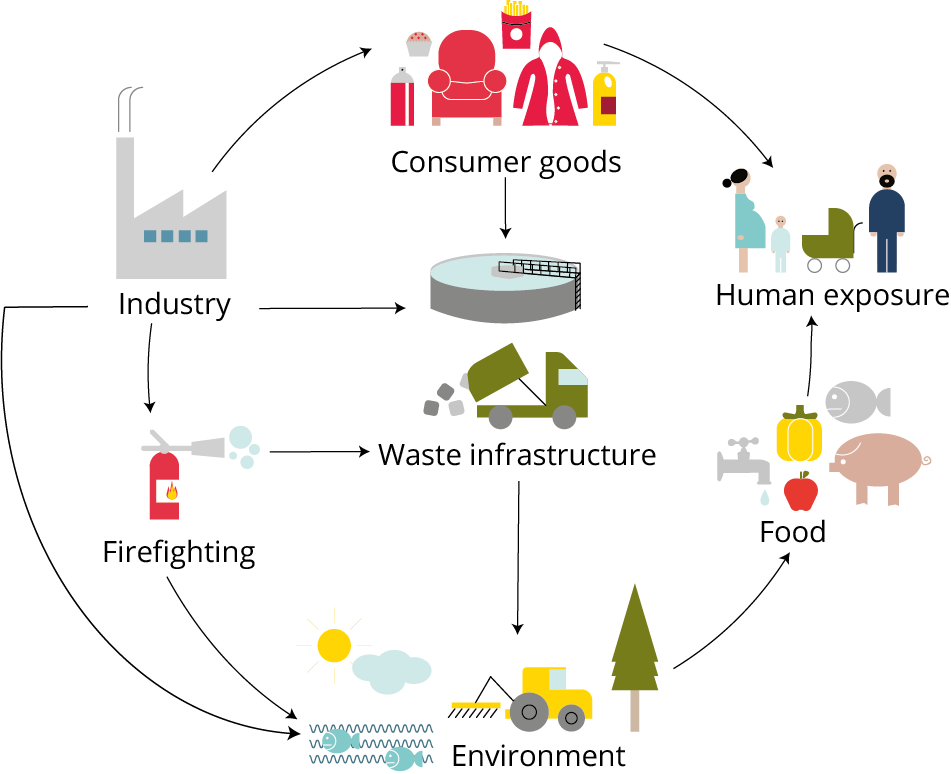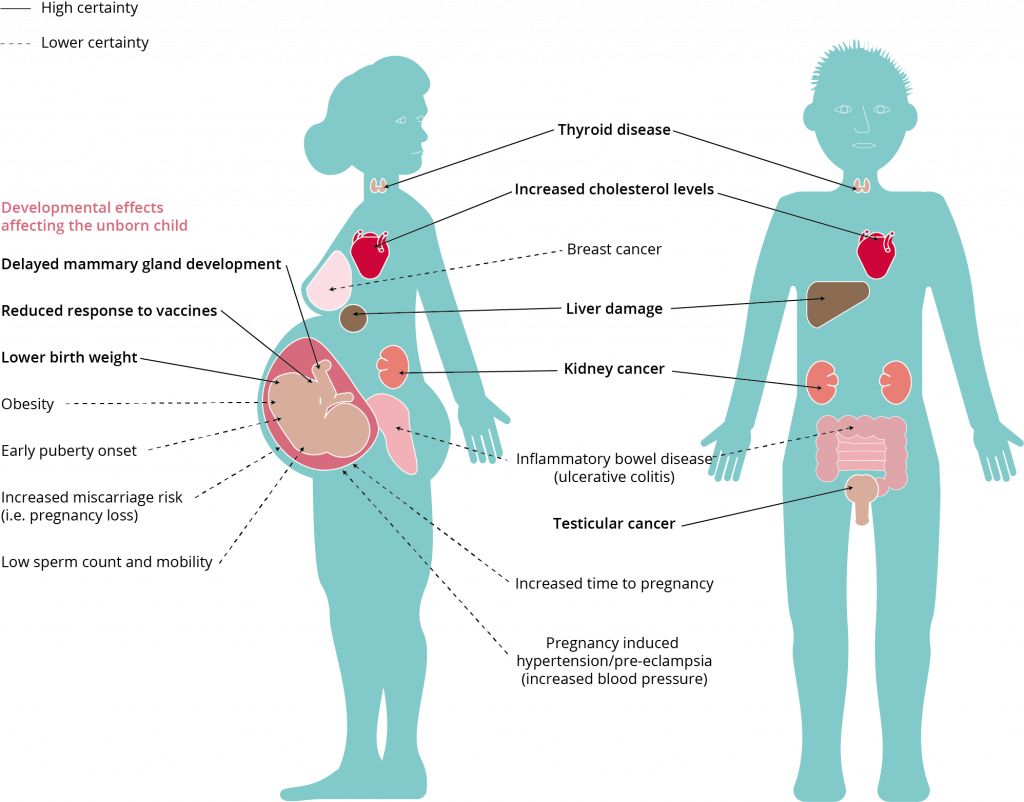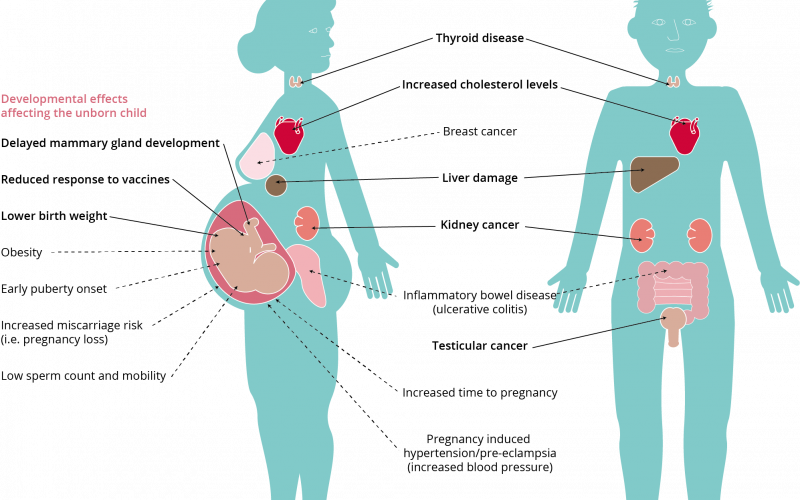Last Updated on August 14, 2024 by Ecologica Life
Have you heard of forever chemicals (AKA PFAS)? You probably should have.
PFAS (Per- and polyfluorinated alkyl substances), also known as the Forever Chemicals, are a family of 4,700 highly persistent chemicals that don’t occur on Earth by natural means.
They are a range of chemicals that include flame retardants, herbicides, insect repellents, insecticides, textiles, personal care and consumer product chemicals.
We are currently mass-producing forever chemicals. Unfortunately, research from the previous few decades has shown that they can accumulate in our bodies and be detrimental to the health of ourselves, our families and life on this planet.
Table of Contents
Where Do PFAS Come From?

Since the 1950s, PFAS have been utilised in a wide range of consumer items all over the world. Today, they can be found in items like firefighting foam, non-stick cookware, and cosmetics.
PFAS are particularly attractive to layer on materials because they protect against grease, oil, and water. Examples include stain-resistant carpeting and fabrics, food packaging, and water-repellent clothing. PFAS can be found in all aspects of daily life.
PFAS are used unnecessarily in food packaging in many countries. Research has been carried out to measure the amount of PFAS used in food packaging across Europe. Out of 42 samples sent for analysis, 32 samples including packaging from major global fast-food chains such as McDonald’s, KFC, Subway, or Dunkin’ Donuts showed an intentional treatment with PFAS.
In Denmark, the use of forever chemicals in paper and board food packaging has been banned since July 2020. The study found that none of the sampled McDonald’s french fries bags brought in Denmark exhibited PFAS treatment. However, intentional PFAS treatment was found for the same items bought in the Czech Republic and the United Kingdom.
This demonstrates how laws can shield citizens from dangerous chemicals. It also emphasises how varied degrees of protection exist in various nations as a result of the absence of unified standards for food contact materials across the EU.
Workers who repeatedly come into contact with PFAS are more likely to be at risk. This includes those working in PFAS manufacturing factories, personnel using certain products in manufacturing (such as hard-chrome plating), and personnel using the product in a professional capacity (e.g., in firefighting equipment and ski wax).
PFAS Health Effects

The health effects related to forever chemicals are only starting to become understood. According to a 993-page review published by the U.S. Centers for Disease Control and Prevention (CDC), exposure to PFAS are associated with:
- Cancer
- Liver damage
- Decreased fertility
- Increased risk of Asthma
- Increased risk of thyroid disease
PFAS have even been shown to be transferred from mother to foetus. PFAS can continue to accumulate in the organs and tissues of the child over their lifetime if they are continually exposed to them.
The danger of PFAS has been recognised over the last few decades and as a result, some of them have been regulated and/or banned. Evidence suggests that legislation has had an effect and many populations in Europe (such as Belgium, Denmark, Finland, Spain and Sweden) have experienced a decrease in studied PFAS in their blood.
Because there are so many types of PFAS, only few of them have been well studied. Those that have been studied have seen significant effects on endocrine, immune, reproductive systems as well as during infant development.
The continued exposure to the cocktail of these chemicals is not good for the bodies of us and the other species on this planet. In Europe, it is now estimated that PFAS cost an annual 52-84 billion in health costs.
PFAS in Blood and The Body
The European Human Biomonitoring Initiative (HBM4EU) measured 12 PFAS chemicals in European teenagers (12-18) between 2014-2021. The graph below shows the percentage of teenagers from nine European countries with combined blood levels of PFAS above the health-based guidance value.

In all nine countries a share of teenagers had blood levels of PFAS above the health-based guidance value, ranging from 1% in Spain to 24% in France. Higher levels were found in boys rather than girls, as well as teenagers from households with a higher education level.
Research performed in Germany was able to measure a spectrum of 37 PFAS present in human blood during 2009-2019. Although there was a significant decrease in concentrations of several PFAS over the years. This is due to many PFAS becoming banned in the EU. Two different PFAS were still detectable in blood samples even after them being banned for some years.
PFAS accumulate in different organs in the body, with one study showing PFAS accumulated most in the lungs. One study carried out in Southern Spain even detected PFAS in breast milk.
PFAS in The Environment
PFAS have been detected in from the snow in Mount Everest to rainwater; soils and wild bird eggs; in birds and mammals as well as fish. PFAS have been found in water supplies in several European countries.
Around PFAS manufacturing and production facilities, such as Antwerp in Belgium and Dordrecht in the Netherlands, significant environmental pollution has been discovered.
The majority of the PFAS pollution at the Antwerp site is caused by PFOS, a so-called “long chain” PFAS that builds up in humans and other living things. PFOS is now mostly banned, but because it is so persistent, it still exists in the environment.
“Short-chain” PFAS were used instead of “long-chain” PFAS as these were thought to accumulate less in humans. One example of these is GenX, which is the source of pollution in the area surrounding the Dordrecht factory in the Netherlands. GenX has now been shown to have its own negative health effects to the liver and blood as well as cancer of the liver, pancreas, and testicles. Short-chain PFAS have been found in higher concentrations in breast milk, it is likely that these short-chain PFAS come from skin care and makeup products.
The issue is that legislation does not keep up with the understanding of how new chemicals affect us. Once scientists do understand the damaging effects of a chemical used in manufacturers, it is just swapped out for another one. By that time the chemical is already widespread in the environment and due to its longevity, may continue to be present in the environment for many years to come.
New Method to Destroy Forever Chemicals

However, it is not all doom and gloom. Scientists are putting their heads together to remove forever chemicals from our lives. One research group from the University of California, have developed a way to break down forever chemicals in drinking water using ultraviolet light (UV).
The researchers first added hydrogen to the water to make the PFAS more reactive. They then exposed the water to high-energy UV, which promotes reactions to destroy the PFAS. Not only are the problematic carbon-fluoride bonds broken, but the reactions turn the PFAS into by-products that are thought to be harmless.
According to the research, almost 100 percent of the PFAS were destroyed. The researchers are now working on improving this technology, which is patent pending, in the hopes that it can be more widely used.
What is Being Done About Forever Chemicals
Slowly but surely, more countries are taking legislative action to protect citizens against PFAS. PFAS are being restricted and banned in the EU. Some countries have set limits for PFAS in water and soil (Denmark, Germany, the Netherlands, and Sweden), for textiles (Norway) and for food contact materials (Denmark).
Because there are more than 4700 PFAS, they are beginning to be regulated as a class of chemically similar chemicals instead of individually.
In order to achieve zero pollution, product life cycles must be made safer from the moment they are manufactured. This is based on the idea of safe-and-circular-by-design. With this strategy, there is a chance to protect the environment and the health of individuals while still promoting commerce and economic growth.
More can be found about the EU’s chemical strategy from 2020 here.
If you would like to discuss with us any of the content found here. Get in touch.
References and Further Reading
- https://www.eea.europa.eu/publications/zero-pollution/cross-cutting-stories/pfas
- https://www.eionet.europa.eu/etcs/etc-wmge/products/etc-wmge-reports/fluorinated-polymers-in-a-low-carbon-circular-and-toxic-free-economy
- https://www.hbm4eu.eu/wp-content/uploads/2022/06/HBM4EU_Policy-Brief-PFAS.pdf
- https://chemtrust.org/pfas_eu_packaging/








